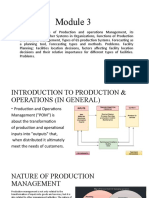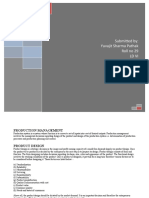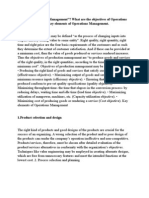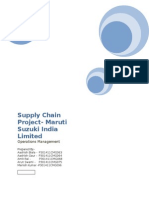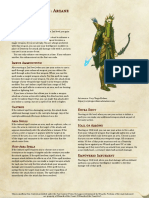0 ratings0% found this document useful (0 votes)
96 viewsIntroduction To Basic Manufacturing Process
This document provides an introduction to basic manufacturing processes and workshop technology. It discusses key concepts including manufacturing engineering, production processes, process planning, inspection and quality control, mechanization and automation, computer-aided manufacturing, and manufacturing systems. The document emphasizes that manufacturing is essential for industrialized nations and requires knowledge of various processes, tools, and safety practices.
Uploaded by
Nyan HtetwinCopyright
© © All Rights Reserved
Available Formats
Download as PPTX, PDF, TXT or read online on Scribd
0 ratings0% found this document useful (0 votes)
96 viewsIntroduction To Basic Manufacturing Process
This document provides an introduction to basic manufacturing processes and workshop technology. It discusses key concepts including manufacturing engineering, production processes, process planning, inspection and quality control, mechanization and automation, computer-aided manufacturing, and manufacturing systems. The document emphasizes that manufacturing is essential for industrialized nations and requires knowledge of various processes, tools, and safety practices.
Uploaded by
Nyan HtetwinCopyright
© © All Rights Reserved
Available Formats
Download as PPTX, PDF, TXT or read online on Scribd
You are on page 1/ 23
Introduction to Basic Manufacturing
Process and Workshop Technology
Aung Myo Lwin, M.Eng, Ph.D
Introduction
Manufacturing is the backbone of any industrialized nation.
Manufacturing and technical staff in industry must know the
various manufacturing processes, materials being processed,
tools and equipment's for manufacturing different
components or products with optimal process plan using
proper precautions and specified safety rules to avoid
accidents.
Beside above, all kinds of the future engineers must know
the basic requirements of workshop activities in term of
man, machine, material, methods, money and other
infrastructure facilities needed to be positioned properly for
optimal shop layouts or plant layout and other support
services effectively adjusted or located in the industry or
plant within a well planned manufacturing organization.
Manufacturing Engineering
• Manufacturing is derived from the Latin word
manufactus, means made by hand.
• In modern context, manufacturing involves making
products from raw material by using various
processes, by making use of hand tools, machinery
or even computers.
• It is therefore a study of the processes required to
make parts and to assemble them in machines.
Advance manufacturing engineering involves the following concepts
1. Process planning
2. Process sheets
3. Route sheets
4. Tooling
5. Cutting tools, machine tools (traditional, numerical control (NC),
and computerized numerical control (CNC)
6. Jigs and Fixtures
7. Dies and Moulds
8. Manufacturing Information Generation
9. CNC part programs
10. Robot programmers
11. Flexible Manufacturing Systems (FMS), Group Technology (GT)
and Computer integrated manufacturing (CIM)
Production Process
• It is the process followed in a plant for converting semi-
finished products or raw materials into finished products or
raw materials into finished products.
• The art of converting raw material into finished goods with
application of different types of tools, equipments, machine
tools, manufacturing set ups and manufacturing processes, is
known as production.
• Generally there are three basic types of production system
that are given as under
1. Job production (Single job)
2. Batch production (200 – 800)
3. Mass production (> 50000)
Process Planning
Process planning consists of selection of means of
production (machine-tools, cutting tools, presses, jigs,
fixtures, measuring tools etc.), establishing the efficient
sequence of operation, determination of changes in form,
dimension or finish of the machine tools in addition to the
specification of the actions of the operator.
It includes the calculation of the machining time, as well as
the required skill of the operator.
It also establishes an efficient sequence of manufacturing
steps for minimizing material handling which ensures that
the work will be done at the minimum cost and at maximum
productivity.
Classification of Manufacturing Process
• For producing of products materials are needed. It is
therefore important to know the characteristics of the
available engineering materials.
• Raw materials used manufacturing of products, tools,
machines and equipments in factories or industries are
extracted from ores.
• The ores are suitably converted the metal into a molten form
by reducing or refining processes in foundries. This molten
metal is poured into moulds for providing commercial
castings, called ingots.
• Such ingots are then processed in rolling mills to obtain
market form of material supply in form of bloom, billets,
slabs and rods.
• These forms of material supply are further subjected
to various manufacturing processes for getting
usable metal products of different shapes and sizes
in various manufacturing shops.
• All these processes used in manufacturing concern
for changing the ingots into usable products may be
classified into six major groups as primary shaping
processes, secondary machining processes, metal
forming processes, joining processes, surface
finishing processes and processes effecting change
in properties.
Product Simplification and
Standardization
• The technique of simplification and standardization of
product is closely inter-related that leads to higher efficiency
in production, better quality and reduced production cost.
• Simplification is a process of determining limited number of
grades, types and sizes of a components or products or parts
in order to achieve better quality control, minimize waste,
simplify production and, thus, reduce cost of production.
• By eliminating unnecessary varieties, sizes and designs,
simplification leads to manufacture identical components or
products for interchangeability and maintenance purposes of
assembly of parts.
• Standardization is the important step towards interchangeable
manufacture, increased output and higher economy.
Inspection and Quality Control
• A product is manufactured to perform desired functions.
• It must have a specified dimension such as length, width,
height, diameter and surface smoothness to perform or
accomplish its intended function.
• It means that each product requires a defined size, shape
and other characteristics as per the design specifications.
• For manufacturing the product to the specified size, the
dimensions should be measured and checked during and
after the manufacturing process.
• It involves measuring the size, smoothness and other
features, in addition to their checking.
• These activities are called measurement and inspection
respectively.
Mechanization and Automation
• Mechanization means something is done or operated by
machinery and not by hand.
• Mechanization of the manufacturing means is milestone
oriented trend towards minimizing the human efforts to the
extent of its possibility, by adopting mechanical and
electrical means or methods for automating the different
manufacturing processes.
• Such a trend may be in the area of automating and
mechanizing the processes of material handling, loading and
unloading of components, actual operations performed on
the job or transportation, etc.
The reasons why one should go for automation are:
1. Increased productivity
2. Reduced cost of labor and dependence on labor shortages
3. Improved quality
4. Reduced in-process inventory
5. Reduced manufacturing time
6. Reduced dependence on operator skills
7. Increased safety or reduced risk of humans.
Automation can be classified into three categories, viz.
8. Fixed automation
9. Programmable automation
10. Flexible automation.
Computer Aided Manufacturing
• The computer aided manufacturing implies manufacturing
itself, aided or controlled by computers.
• In a wider sense, it denotes all the activities in the
manufacturing environment like use of computers in
inventory control, project management, material requirement
planning, data acquisition, testing and quality control.
• Computer Numerical Control (CNC) machines used in
production and the part programs being made by the stored
geometry from the design stage, the scrap level would be
reduced to the minimum possible and almost no rework
would be necessary.
Manufacturing System
• Manufacturing basically implies making of goods or articles
and providing services to meet the needs of mankind.
• It creates value by useful application of physical and mental-
labor in the process.
• It is a chain of interrelated activities of production process
and other support services activities of an manufacturing
environment such as order processing, product design,
design and manufacturing of tools, die, mould, jigs, fixtures
and gauges, selection of material, planning, managing and
maintaining control of the processes, production, and
reliable quality of processed product in a systematic and
sequential manner with proper coordination, cooperation and
integration of the whole manufacturing system that will lead
to economical production and effective marketing of
proposed product in the minimum possible time.
Product Development
A product development has to go through the following concepts of
product engineering which are given as under.
Product functions
1. Product specifications
2. Conceptual design
3. Ergonomics and aesthetics
4. Standards
5. Detailed design
6. Prototype development
7. Testing
8. Simulation
9. Design for manufacture
10. Design for assembly
11. Drafting.
Computers in Manufacturing Industries
• Factors governing increased productivity, more
accuracy, greater flexibility of shapes, and reduced
manufacturing costs are forcing the manufacturing
concerns to use computers in design, manufacturing
and other allied functions of industrial activities.
• In today’s time, computer applications have
progressed considerably in all areas of design and
manufacturing involving CAD and CAM.
Today, computers are not only used in manufacturing but they
play also an important role in all manufacturing related
activities such as business or financial management, factory
level production management, CIM technologies, CAD,
feature and solid modelling, and CAM, manufacturing
information, manufacturing system.
Business or Financial Management
1. Costing
2. Sales and Marketing
3. Purchase Order Control
4. Vendors
5. Subcontracting
6. Personnel.
Factory Level Production management
1. Planning
2. Production Management
3. Manufacturing production scheduling (MPS)
4. Material requirement planning (MRP)
5. Just in time (JIT)
6. Bill of Materials
7. Capacity Planning
8. Inventory Control.
CIM Technologies
1. Computer Networks
2. System Design and Analysis
3. Distributed Processing
4. Database Management Manufacturing
5. Modelling and Simulation
6. Expert Systems
7. Quality Engineering.
Computer Aided Design (CAD)
This area is also known Feature and Solid Modelling.
1. Variational and Parametric
2. Modelling
3. Computer Graphics
4. Graphic Standards
5. Inter-graphics exchange specification (IGES)
6. Data exchange file (DXF)
7. Manufacturing Robot Programming
8. Design Analyses Tools
9. Programming
10. Finite element modelling (FEM)
11. Finite element analysis (FEA)
12. Simulation
13. Mechanisms
14. Test and Analysis
15. Design Tools Mechanical
16. Hydraulic, Electronics, etc.
Computer Aided Manufacturing (CAM)
This involves activities related to manufacturing information
and manufacturing system.
Manufacturing Information
1. Generation
2. Process Planning
3. Production Planning
4. Computer numerical control (CNC) part Programming
5. Robot Programming
6. Coordinate measuring machine (CMM) Programming.
Manufacturing System
1. Production Activity
2. Machining
3. Assembly
4. Material Handling
5. Storage
6. Production Control
7. Loading
8. Scheduling
9. Balancing
10. Capacity Planning
11. Quality Control.
You might also like
- Foundation of Business Lecture - 7: Productions and Operations ManagementNo ratings yetFoundation of Business Lecture - 7: Productions and Operations Management16 pages
- Week 1 Lesson It 311 Intro To Manufacturing TechnologyNo ratings yetWeek 1 Lesson It 311 Intro To Manufacturing Technology30 pages
- Responsibilities of Process Planning Engineer0% (1)Responsibilities of Process Planning Engineer115 pages
- SCDL - PGDBA - Finance - Sem 2 - Production & Operations Managment91% (11)SCDL - PGDBA - Finance - Sem 2 - Production & Operations Managment32 pages
- 05_OM_Chapter 4_Process Selection and Facility LayoutNo ratings yet05_OM_Chapter 4_Process Selection and Facility Layout10 pages
- 17PME328E: Process Planning and Cost EstimationNo ratings yet17PME328E: Process Planning and Cost Estimation48 pages
- Process Selection: Influence That Process Has On An OrganizationNo ratings yetProcess Selection: Influence That Process Has On An Organization8 pages
- FALLSEM2023-24 MEE2013 ETH VL2023240101818 2023-07-26 Reference-Material-INo ratings yetFALLSEM2023-24 MEE2013 ETH VL2023240101818 2023-07-26 Reference-Material-I21 pages
- Computer Aided Manufacturing: M.Palanivendhan Department of Automobile Engineering SRM University, Kattankulathur CampusNo ratings yetComputer Aided Manufacturing: M.Palanivendhan Department of Automobile Engineering SRM University, Kattankulathur Campus122 pages
- Me6703 2 Mark Questions Bright StudentsNo ratings yetMe6703 2 Mark Questions Bright Students15 pages
- Application of Computer in Textile IndustryNo ratings yetApplication of Computer in Textile Industry25 pages
- Course Mba - 2 Semester Subject Assignment MB0044 - Set 1: Production and Operations ManagementNo ratings yetCourse Mba - 2 Semester Subject Assignment MB0044 - Set 1: Production and Operations Management14 pages
- Design of Manufacturing Processes General ConceptsNo ratings yetDesign of Manufacturing Processes General Concepts5 pages
- Process-Selection-and-Facility-Layout (1)No ratings yetProcess-Selection-and-Facility-Layout (1)27 pages
- Department of Mechanical Engineering: CNC MachinesNo ratings yetDepartment of Mechanical Engineering: CNC Machines10 pages
- What Is "Operations Management"? What Are The Objectives of Operations Management? Enlist Key Elements of Operations ManagementNo ratings yetWhat Is "Operations Management"? What Are The Objectives of Operations Management? Enlist Key Elements of Operations Management42 pages
- Unit - IV Production System: by Dilip Johari (Asst. Prof.) Mechanical Engineering DepartmentNo ratings yetUnit - IV Production System: by Dilip Johari (Asst. Prof.) Mechanical Engineering Department22 pages
- Process Selection and Facility Layout: Presented by Group 6 (BSA1A)No ratings yetProcess Selection and Facility Layout: Presented by Group 6 (BSA1A)91 pages
- Mechanical Production Engineer Success: Careers, Interview Q&A, and TerminologyFrom EverandMechanical Production Engineer Success: Careers, Interview Q&A, and TerminologyNo ratings yet
- (Hong 2011) Theoretical modeling for a rotor-bearing-foundation system and its dynamic characteristiNo ratings yet(Hong 2011) Theoretical modeling for a rotor-bearing-foundation system and its dynamic characteristi12 pages
- (Lionel Casson) Libraries in The Ancient WorldNo ratings yet(Lionel Casson) Libraries in The Ancient World190 pages
- Powder Metallurgy For 2025 & 2026 GATE ESE PSUs by S K MondalNo ratings yetPowder Metallurgy For 2025 & 2026 GATE ESE PSUs by S K Mondal13 pages
- Sample Social Media Policy For EmployersNo ratings yetSample Social Media Policy For Employers3 pages
- Almeida Theatre Production of Homecoming by PinterNo ratings yetAlmeida Theatre Production of Homecoming by Pinter34 pages
- JI-Pengaruh Disiplin, Gaya Kepemimpinan, Dan Lingkungan Kerja Terhadap Kinerja Pegawai Melalui Motivasi Di Sekretariat Jenderal DPR RINo ratings yetJI-Pengaruh Disiplin, Gaya Kepemimpinan, Dan Lingkungan Kerja Terhadap Kinerja Pegawai Melalui Motivasi Di Sekretariat Jenderal DPR RI22 pages
- Contingency Perspectives of Organizational Strategy - A Critical Review of The Empirical ResearchNo ratings yetContingency Perspectives of Organizational Strategy - A Critical Review of The Empirical Research15 pages
- 49 Illegal Operating TV Stations To Be Shut Down Final 2100% (1)49 Illegal Operating TV Stations To Be Shut Down Final 22 pages
- In The Previous Lesson On It States That T100% (1)In The Previous Lesson On It States That T16 pages
- Foundation of Business Lecture - 7: Productions and Operations ManagementFoundation of Business Lecture - 7: Productions and Operations Management
- Week 1 Lesson It 311 Intro To Manufacturing TechnologyWeek 1 Lesson It 311 Intro To Manufacturing Technology
- SCDL - PGDBA - Finance - Sem 2 - Production & Operations ManagmentSCDL - PGDBA - Finance - Sem 2 - Production & Operations Managment
- 05_OM_Chapter 4_Process Selection and Facility Layout05_OM_Chapter 4_Process Selection and Facility Layout
- Process Selection: Influence That Process Has On An OrganizationProcess Selection: Influence That Process Has On An Organization
- FALLSEM2023-24 MEE2013 ETH VL2023240101818 2023-07-26 Reference-Material-IFALLSEM2023-24 MEE2013 ETH VL2023240101818 2023-07-26 Reference-Material-I
- Computer Aided Manufacturing: M.Palanivendhan Department of Automobile Engineering SRM University, Kattankulathur CampusComputer Aided Manufacturing: M.Palanivendhan Department of Automobile Engineering SRM University, Kattankulathur Campus
- Course Mba - 2 Semester Subject Assignment MB0044 - Set 1: Production and Operations ManagementCourse Mba - 2 Semester Subject Assignment MB0044 - Set 1: Production and Operations Management
- Design of Manufacturing Processes General ConceptsDesign of Manufacturing Processes General Concepts
- Department of Mechanical Engineering: CNC MachinesDepartment of Mechanical Engineering: CNC Machines
- What Is "Operations Management"? What Are The Objectives of Operations Management? Enlist Key Elements of Operations ManagementWhat Is "Operations Management"? What Are The Objectives of Operations Management? Enlist Key Elements of Operations Management
- Unit - IV Production System: by Dilip Johari (Asst. Prof.) Mechanical Engineering DepartmentUnit - IV Production System: by Dilip Johari (Asst. Prof.) Mechanical Engineering Department
- Process Selection and Facility Layout: Presented by Group 6 (BSA1A)Process Selection and Facility Layout: Presented by Group 6 (BSA1A)
- Mechanical Production Engineer Success: Careers, Interview Q&A, and TerminologyFrom EverandMechanical Production Engineer Success: Careers, Interview Q&A, and Terminology
- Practical Guide To Production Planning & Control [Revised Edition]From EverandPractical Guide To Production Planning & Control [Revised Edition]
- (Hong 2011) Theoretical modeling for a rotor-bearing-foundation system and its dynamic characteristi(Hong 2011) Theoretical modeling for a rotor-bearing-foundation system and its dynamic characteristi
- Powder Metallurgy For 2025 & 2026 GATE ESE PSUs by S K MondalPowder Metallurgy For 2025 & 2026 GATE ESE PSUs by S K Mondal
- Almeida Theatre Production of Homecoming by PinterAlmeida Theatre Production of Homecoming by Pinter
- JI-Pengaruh Disiplin, Gaya Kepemimpinan, Dan Lingkungan Kerja Terhadap Kinerja Pegawai Melalui Motivasi Di Sekretariat Jenderal DPR RIJI-Pengaruh Disiplin, Gaya Kepemimpinan, Dan Lingkungan Kerja Terhadap Kinerja Pegawai Melalui Motivasi Di Sekretariat Jenderal DPR RI
- Contingency Perspectives of Organizational Strategy - A Critical Review of The Empirical ResearchContingency Perspectives of Organizational Strategy - A Critical Review of The Empirical Research
- 49 Illegal Operating TV Stations To Be Shut Down Final 249 Illegal Operating TV Stations To Be Shut Down Final 2








